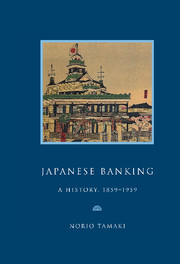Book contents
- Frontmatter
- Contents
- Preface
- Genealogy of leading Japanese banks, 1859–1959
- List of abbreviations
- Map
- Part I A bankrupt Shogunate, 1859–1868
- Historical background
- 1 Japanese merchant bankers: ryogae, 1859–1868
- 2 A bankrupt regime, 1859–1866
- 3 Ryogae struggling for survival, 1859–1868
- 4 The arrival of western banking, 1863–1868
- Part II The Meiji Restoration: monetary confusion and banking experiments, 1868–1881
- Part III Matsukata, the wizard of Japanese banking, 1881–1897; the Yokohama Specie Bank (1880) and the Bank of Japan (1882)
- Part IV The Japanese on the London money market, 1897–1911
- Part V War, the Japanese boom years, 1911–1919
- Part VI Crisis and the road to war, 1919–1937
- Part VII Complete commitment, struggle and defeat, 1937–1945
- Part VIII American ‘democratisation’ and the search for growth, 1945–1959
- An extraordinary century, 1859–1959
- Appendices
- Notes
- Bibliography
- Index
Historical background
Published online by Cambridge University Press: 03 February 2010
- Frontmatter
- Contents
- Preface
- Genealogy of leading Japanese banks, 1859–1959
- List of abbreviations
- Map
- Part I A bankrupt Shogunate, 1859–1868
- Historical background
- 1 Japanese merchant bankers: ryogae, 1859–1868
- 2 A bankrupt regime, 1859–1866
- 3 Ryogae struggling for survival, 1859–1868
- 4 The arrival of western banking, 1863–1868
- Part II The Meiji Restoration: monetary confusion and banking experiments, 1868–1881
- Part III Matsukata, the wizard of Japanese banking, 1881–1897; the Yokohama Specie Bank (1880) and the Bank of Japan (1882)
- Part IV The Japanese on the London money market, 1897–1911
- Part V War, the Japanese boom years, 1911–1919
- Part VI Crisis and the road to war, 1919–1937
- Part VII Complete commitment, struggle and defeat, 1937–1945
- Part VIII American ‘democratisation’ and the search for growth, 1945–1959
- An extraordinary century, 1859–1959
- Appendices
- Notes
- Bibliography
- Index
Summary
The opening of Japan to the western powers in 1859, after a 230-year seclusion, was to prove fatal to the Tokugawa Shogunate regime. Shogunal concessions, agreeing to open Japanese ports to foreigners, aroused, especially among the influential feudal lords and their samurai subjects, bitter passions which were embodied in the slogan ‘Revere the Emperor, expel the barbarian’. This extremist slogan and movement, however, did not survive even the first half of the 1860s when two of the strongest domains, Satsuma and Choshu, reversed their anti-foreign stance. These two enlightened domains, situated in the far south-west of Japan where western things and influences entered Japan via Nagasaki, recognised the brutal reality, following the western powers' bombardment of Kagoshima, the capital of Satsuma, and Shomonseki in Chosu territory, that ‘expel the barbarian’ policies were absurd. The union of the two domains, armed with some rudimentary western science, technology and, above all, modern weapons, gathered forces at an astonishing speed to lead the attack on the Shogunate from the autumn of 1867 to the spring of 1868. As the young samurai of Satsuma and Chosu and their allies had to shoulder all the burdens, including those of financial management, in a new administration (the Meiji government), an enormous amount of hitherto pent-up energy of young ex-samurai was released. For the time being, of necessity, the young oligarchs had no option but to rely heavily on the old merchant bankers.
- Type
- Chapter
- Information
- Japanese BankingA History, 1859–1959, pp. 3Publisher: Cambridge University PressPrint publication year: 1995



